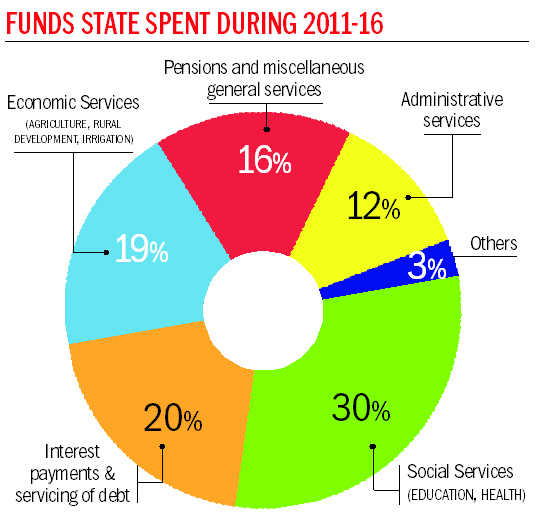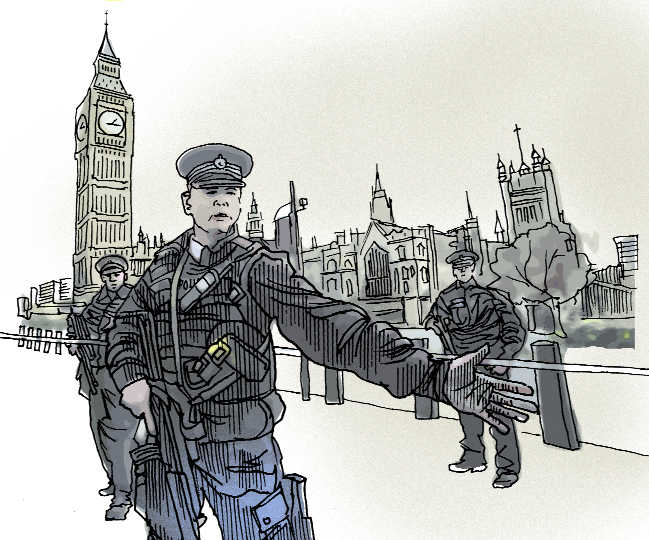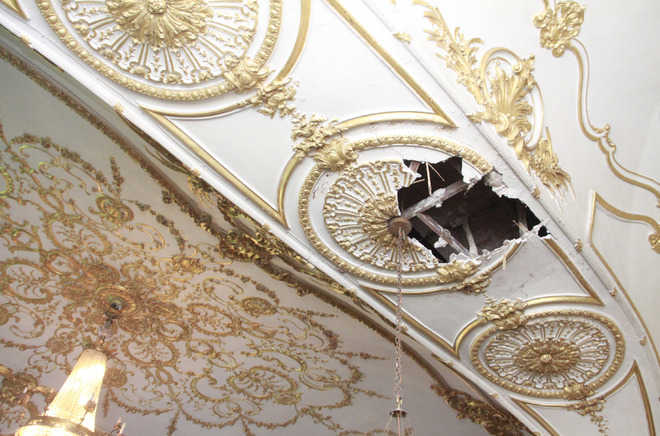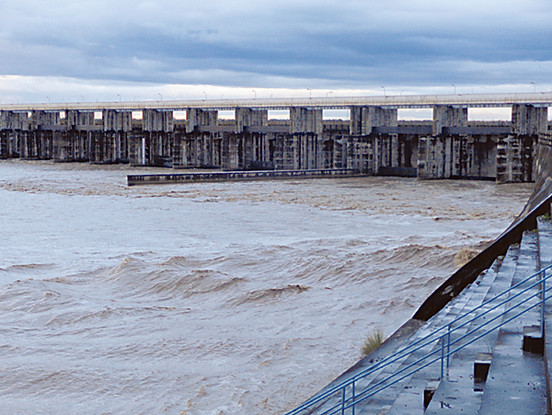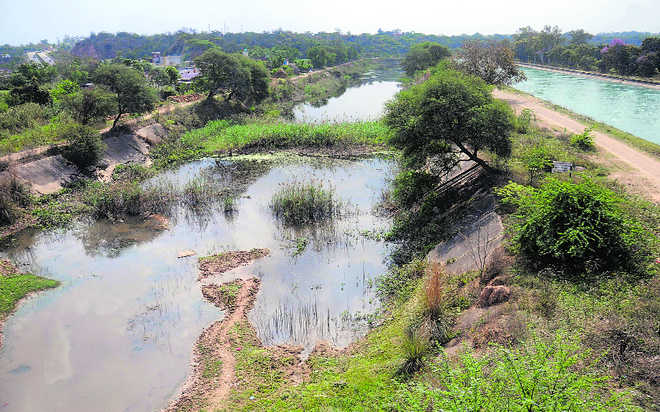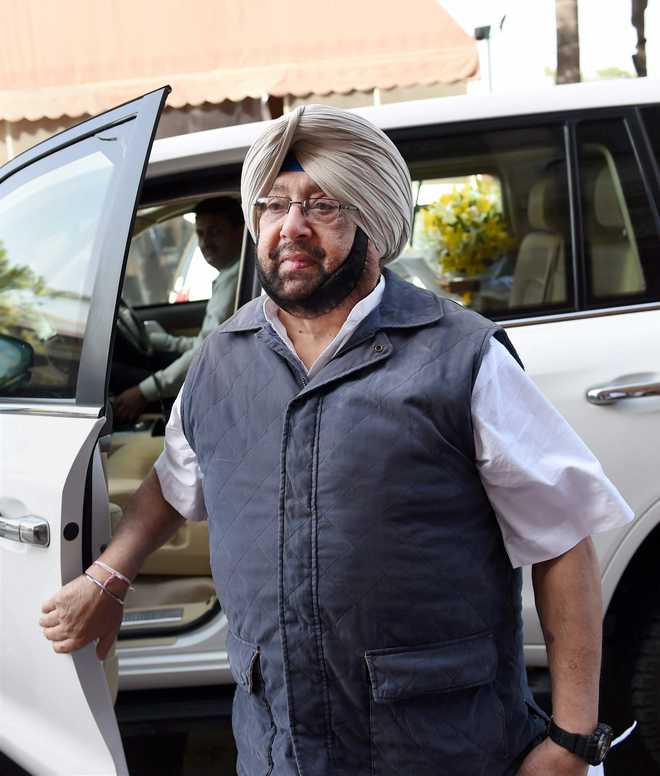Vishav Bharti
Tribune News Service
Chandigarh, March 29
The last five years of the SAD-BJP government saw public debt increase by almost Rs10,000 crore every year. This was the time when then Deputy Chief Minister Sukhbir Singh Badal made claims about ‘Progressive Punjab’.The outcome of the financial mess is that Punjab is now under debt of more than Rs1 lakh crore. A bigger worry is that around 60 per cent of the loans have to be paid in seven years.The Comptroller Auditor General (CAG) of India, in its report released today, called it an alarming situation.The report on the state’s finances said the total debt on Punjab was around Rs64,000 crore in 2011-12 and it swelled to Rs1.03 lakh crore in 2015-16. This means that in five years, debt shot up by Rs10,000 crore every year. During 2015-16, public debt increased by Rs16,377 crore.Another worry for the state government is nearing of loan deadlines. As per CAG, the state has to repay 58.51 per cent of its debt (more than Rs60,000 crore) in next seven years. The state government has to repay 18 per cent (Rs18,500 crore) of its debt in three years, 18 per cent (Rs18,500 crore) between three and five years, and 23 per cent (Rs23,367 crore) between five and seven years.“This is an alarming position and the state is heading towards a serious debt repayment position, especially when its major irrigation projects had accumulated losses of Rs1,600 crore during 2011-16 and the application of debt raised by the state government towards creation of new assets remained below 6 per cent of total expenditure during 2011-16.“The state needs to formulate a well-thought-out debt management strategy and step up resource mobilisation to ensure debt stability. Unless such efforts are made, the state would face serious debt servicing challenges, which could lead to a situation of debt trap,” the CAG observed.On reasons behind the financial mess, the CAG found that the state’s revenue expenditure increased more than revenue receipts in the past five years. As per the report, revenue receipts increased from Rs26,234 crore in 2011-12 to Rs41,523 crore in 2015-16 at an average annual growth rate of 8.86 per cent. But at the same time, revenue expenditure grew at an average annual growth rate of 8.95 per cent. The revenue expenditure includes salaries, pensions and interest repayment.“The revenue expenditure continued to constitute a dominant proportion (85 per cent to 95 per cent) of the total expenditure during 2011-16,” the CAG said.Jagbans Singh, Principal Accountant General (Audit), Punjab, said: “Earlier, Haryana was considered a much smaller economy than Punjab. But recent Budget figures of Haryana suggest that it is almost one-and-a-half times bigger than Punjab.”The capital expenditure decreased by Rs59 crore (1.89 per cent) over the previous year. “The capital expenditure incurred during 2015-16 was 62.98 per cent of budget estimates which indicates that asset creation was not given as much priority as intended in the budget estimates,” the CAG report observed.
Manpreet blames it on SAD ‘misgovernance’
Ruchika M Khanna
Tribune News Service
Chandigarh, March 29
“Dekhte hi dekhte kafila lut ta chala gaya;Hai sad afsos lutne walon ko bhi khabar nahi hui.”This poetic rendition was given by Finance Minister Manpreet Singh Badal as he described the poor fiscal health of the state while presenting the vote-on-account. He sought the permission of the House to okay the supplementary grants of Rs25,199 crore, the money spent over and above the Budget estimates for this fiscal.Calling the fiscal mess left behind by the previous Akali-BJP government as sheer misgovernance, he said he was appalled at how the government could be so off the mark in presenting its Budget estimates that Rs25,000 crore was spent over and above that. “Meri zubaan katti jave….but these people (pointing towards the Opposition benches where the Akalis were seated) have left generations of Akalis in chains of slavery,” he said, adding that future earnings of the next five years of the Punjab Infrastructure Development Board (PIDB), Punjab Mandi Board and several other government undertakings, had been hypothecated by the previous government with various banks.Though former Finance Minister Parminder Singh Dhindsa and Bikram Singh Majithia did try and defend his party’s government by saying that there was no illegality in spending funds, he was silenced by Local Bodies minister Navjot Singh Sidhu, who said, “Tu na idhar udhar ki baat kar, bata karwan kyun luta.”He also accused the Akalis of doing “chori te seena zori”, when the Akali MLAs tried to scream against the tirade launched against them.Manpreet’s tirade against the previous government continued through most part of the session, who said: “Angrezan ne vi Punjab nu ihni buri tarhan nahin lutteya jiven pichli sarkar ne luttya hai (even the British did not plunder the state as was done by the previous government).”Manpreet said they were working to bring austere governance in Punjab. “No one will be spared… I have no choice,” he said, reiterating his government’s commitment to fix responsibility for the fiscal mess and to conduct a third-party audit of the PSPCL and the PIDB.For a change, if only for a brief while, Leader of Opposition HS Phoolka too supported the Finance Minister’s decision to bring a White Paper. He, however, insisted that the White Paper should cover the fiscal mess which had been created under different governments during the past 20 years.Sukhpal Khaira, too, supported him, saying the custodians of the treasury were the ones who looted it, and urged the Congress against making political appointments that would be a drain on the state exchequer.Congress MLA Sukhjinder Singh Randhawa demanded that the government punished all, including the bureaucrats, who helped the previous government in cheer haran of Punjab.Manpreet, who presented the vote-on-account for Rs29,389 crore for the first three months of the next fiscal, beginning April 1, said that the White Paper on the state of economy was being prepared and it would be presented in the House during the Budget session. He sought the permission of Punjab Vidhan Sabha to consider and pass Rs29,389 crore.Other than this, the Vidhan Sabha passed the supplementary grants worth Rs25,199 crore (of which Rs6061.38 crore is on the revenue account), which is the amount that was spent over and above the budgetary estimates.
Bill on engaging law officers passed
Tribune News Service
Chandigarh, March 29
The Vidhan Sabha today passed The Punjab Law Officers (Engagement) Bill 2017, which paves the way for engagement of law officers in a transparent and fair manner.Chief Minister Capt Amarinder Singh presented the Bill. Advocate General Atul Nanda was present in the House at that time. The Bill paves the way for appointing senior Additional Advocate General, Additional Advocate General, senior Deputy Advocate General, Deputy Advocate General, Assistant Advocate General and advocates on record.The bill says the number of law officers to be engaged under each category may be notified from time to time based on the assessment made by the government. This assessment will to be based on the number of courts, the number of cases and the number of officers already engaged.Of the total posts, 5 per cent have been reserved for district attorneys. Law officers on the remaining posts will be appointed after inviting advertisements. For this purpose, the government will form a scrutiny committee, which will forward applications to the selection committee headed by the Advocate General. The AG has been given the right to engage seven law officers on his own.The Bill also mandates that an advocate whose professional annual income for the past three years is up to Rs20 lakh can be engaged as a senior Additional Advocate General (he has to have 20 years of standing). The income criterion is Rs15 lakh for Additional Advocate General (designate senior having 16 years of standing); Rs10 lakh for senior Deputy Advocate General (14 years of standing); Rs7 lakh for Deputy Advocate General (10 years of standing); Rs3.5 lakh for Assistant Advocate General (three years of standing).
Sidhu tosses drug barb at Akalis
Chandigarh: Left without the leader of their party, Sukhbir Singh Badal, and SAD patriarch Parkash Singh Badal, Akali MLAs were forced to face the barbs directed at them from both the treasury benches and the Opposition benches occupied by AAP and its ally Lok Insaaf Party. The 16 MLAs of the SAD and the BJP (barring the Badals) were trounced by the other two parties over the financial condition of the state and the drug menace. It all began when Akali MLA NK Sharma began the debate, seeking CM’s clarification on a news report appeared in The Tribune on Wednesday regarding farmers being issued recovery notices by banks. “I want to know that if you have decided to get their debt waived, why farmers are being issued notices,” he said. Though CM Capt Amarinder Singh assured the House of expediting the matter, the MLAs on the treasury benches reacted sharply. Local Bodies Minister Navjot Singh Sidhu said: “For 10 years you were sleeping like kumbhkaran, you have no right to speak against us as our Cabinet does not sell chitta like you did.” tns
Out on debt recovery, bankers held hostage
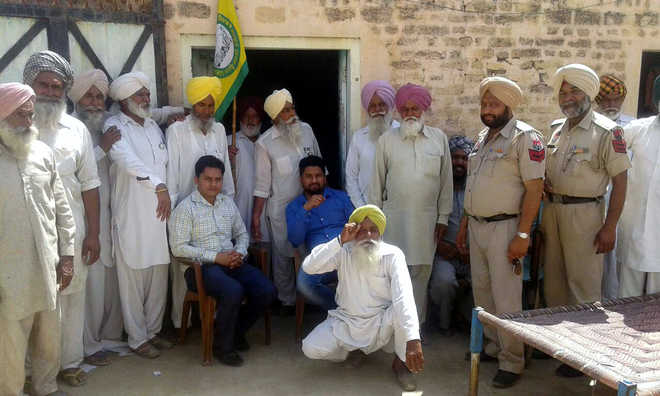 Two bank officials (sitting on chairs) detained by BKU activists at Raonta village in Moga on Wednesday. Tribune Photo
Two bank officials (sitting on chairs) detained by BKU activists at Raonta village in Moga on Wednesday. Tribune PhotoKulwinder Sandhu
Tribune News Service
Moga, March 29
Two bank employees, including a manager, were today taken hostage for a few hours by activists of the BKU (Ekta) when they went to the house of farmers Gurjeet Singh and Gurpreet Singh, both brothers, at Raonta village here to recover a loan of Rs 10 lakh from their father, Tek Singh.Tek Singh told mediapersons that the bank officers threatened to arrest him, besides insisting on attaching his property even as their total credit limit was Rs 50 lakh.“We suffered financial losses in the last couple of seasons due to which we could not repay the loan,” Gurjeet Singh said. As the bank officials were sitting in their house, neighbours informed the local BKU activists, who reached the spot and detained the officials. They also raised slogans against them.The farm activists claimed that the government had asked the bank employees not to conduct raids on the houses of farmers for forcibly recovering the loan amount.Later, the bank officials assured the gathering that they would not visit any farmers’ house to recover loan, following which they were released. Bank official Chandan Kumar said both brothers had credit limit of Rs 25 lakh each and the total interest had accumulated to Rs 10 lakh in the past couple of years. “We issued several notices to them but they did not even visit the bank in the past two years,” he claimed.The bank is likely to declare them defaulters on March 31 and they went to their house to inform about it and request them to at least pay the interest amount
Improvement Trusts’ heads, trustees removed
Tribune News Service
Chandigarh, March 29
To revamp a “collapsed structure” of local bodies, Local Government Minister Navjot Singh Sidhu removed chairmen and trustees of all 28 Improvement Trusts in the state.Now, administrators (DCs or SDMs) would head the trusts appointed by the government till further orders, he said.Sidhu said, “The work in local bodies was not specified. The deadlines were never met. There was no verification of the quality of work. A case in point is a Rs 6 crore work in Hoshiarpur that was sublet through illegal tenders.”The Improvement Trusts in the state are at Abohar, Amritsar, Barnala, Bathinda, Batala, Faridkot, Fazilka, Gurdaspur, Hoshiarpur, Jalandhar, Kapurthala, Kartarpur, Khanna, Kotkapura, Ludhiana, Malerkotla, Moga, Nabha, Nangal, Nawanshahr, Pathankot, Patiala, Phagwara, Rajpura, Ropar, Samana, Sangrur and Tarn Taran.The minister said, “An agency from outside Punjab will audit the quality of works of the Local Government Department. Display boards will be installed outside the project sites, mentioning the name of the contractor, job specification, total cost of the project and the deadline.” This week, Sidhu said, the department would divulge action on the loopholes in the current system. “Preliminary findings have brought out that bills were made in the back date because projects were not completed on time. The department’s engineering wing will conduct surprise inspections and report.”
Power corp CMD resigns
Aman Sood
Tribune News Service
Patiala, March 29
Chairman and Managing Director (CMD) of Punjab State Power Corporation Limited (PSPCL) KD Chaudhri today resigned from the post, a day after the state government amended rules “to ensure that a technocrat is replaced with a bureaucrat” to head the Rs 26,000-crore company.The government is yet to appoint a replacement but the new CMD will face a daunting task to run the company which is under a heavy financial burden.Sources say that Chaudhri sent his resignation, through Secretary, Power, A Venu Prasad and vacated his office here today, following which the government asked Prasad to look after the functioning of the company.During Chaudhri’s tenure as the head of the company, the power sector in the state took drastic steps as “from a power-hungry state, Punjab turned to be a power-surplus state”. With the previous SAD-BJP government giving extension after extension to Chaudhri, the PSPCL ensured round-the-clock supply to all sectors from the past two years.Chaudhri was first appointed in June 2010 for a period of one year. Thereafter, he kept getting extensions. The PSEB Engineers Association, a faction of engineers within the PSPCL, was against these extensions. However, the state government continued to back Chaudhri.The Rs 26,000-crore company, as is claimed by the government, faces a debt of over Rs 25,922 crore and is managing its affairs based on loans.
Crackdown on stone crushers in Pathankot
 Despite crackdown, iIlegal mining going on in Abaadgarh village (Pathankot). tribune photo
Despite crackdown, iIlegal mining going on in Abaadgarh village (Pathankot). tribune photoRavi Dhaliwal
Tribune News Service
Pathankot, March 29
The Pathankot administration, after identifying crushing units operating illegally, has ordered a crackdown.The noose has been tightened particularly against 42 stone crushers operating without the mandatory clearance of the Punjab Pollution Control Board and the PSPCL. To compound matters, these units are operating in river beds, violating the Punjab and Haryana High Court orders.“Owners of these units did not have pollution and electricity clearances yet they were operating because they were hand in glove with lower-level officials. They were the ones who had disturbed the already fragile ecological balance of the region,” said an official.People who have mining licences are elated. With the crackdown on unauthorised crushing units showing results and people no longer getting material from these, a heavy rush can be seen at the legal mining points which include Chak Ram Sahai (Gurdaspur) and Shan points (Madhopur). The owner of Guru Nanak Mines at the Shan point said the drive was paying dividends.However, despite the clean-up operation, some units are still operational like crushers in Abaadgarh village of Mirthal. “Crusher owners knew how to play cat and mouse with the administration and the police. The mining being done in Abaadgarh is a case in point,” said a police officer.“We supply material between Rs 135 to Rs 160 per tonne which are the rates decided by the government. However, crusher owners used to supply at a much higher price. Now, this is slowly coming to an end with the administration acting tough against unauthorised mining,” said a businessman who has mining rights.Pathankot Deputy Commissioner (DC) Neelima said action had been initiated against 15 out of 42 crushers. “We are taking action against others too after verifying the details,” she said.Balwinder Singh, Mining Officer, Pathankot, said 10 committees had been formed which had raided illegal points and stopped mining at Beria, Keeria and Narot (both on the Ravi river), Harial and Mirthal (on the Chakki river) and Anear (on the Beas).
Drugs case: Seven jailed for 15 years
Our Legal Correspondent
Ludhiana, March 29
The Court of Additional Sessions Judge Rajiv K Berry has convicted seven persons in a case of recovery of 1,43,28,400 intoxicant capsules, tablets and cough syrups without any permit or licence.They were also facing accusations of indulging in drug smuggling activities worth crores of rupees in Punjab, Haryana, Rajasthan and Himachal. They have been given 15 years of rigorous imprisonment each. They were also ordered to pay a fine of Rs 1 lakh each. Those convicted are Pardeep Choudhary, and Prithi Choudhary of Karnal (Haryana); Sukhraj Singh, Pawan Kumar Goyal and Parveen Kumar of Moga; and Pawan Kumar Malhotra and Sadhu Singh of Ludhiana.However, the court acquitted Puneet Kumar of Sangrur, Deepak Soni, Salem and Sukhdev Singh of Ludhiana finding no convincing evidence against them.Initially, an FIR was registered against three persons on September 19, 2013. During investigation, the police booked other accused. The police claimed to have recovered Parvon Spas capsules (8,65,000), Rexcof cough syrup bottles (1,400), Phenotil tablets (83,50,000), Microtel tablets (9 lakh), Avil injections (12,000) etc.
One teacher each �in 1,170 schools
Vishav Bharti
Tribune News Service
Chandigarh, March 29
The Sarva Shiksha Abhiyan (SSA) funds were released short by Rs1,362 crore during 2011-16, according to the CAG report tabled in the Assembly here today.The SSA is the primary vehicle for implementing the Right To Education (RTE) Act, 2009, and to provide useful and relevant education to all children in the age group of 6-14 years.Besides, 1,170 primary schools in the state are running with single teacher and 572 upper primary schools with less than three teachers, the report said.It also observed that inadequate planning and implementation was evidenced by lack of mapping of neighbourhood schools and data relating to children belonging to weaker sections and disadvantaged groups.The CAG found that only one set of uniform was provided against the required two sets during 2011-16.Besides, excess expenditure of Rs6.76 crore was incurred on purchase of books against the norms fixed by the Ministry of Human Resources and Development.Deployment of resource teachers was not related to the number of children with special needs and the nature of their disability. No norms were fixed by the state for deployment of resource teachers. No resource teacher was appointed in the state in cases of multiple disabilities, cerebral palsy, learning disability and autism spectrum disabilities resulting in deprival of resource support to 18,214 children suffering from these disabilities.The CAG observed that a performance audit of the implementation of the SSA for 2011-16 brought out lack of planning and deficiencies in both financial management and execution of the programme.
Capt Sukhjit Hara, MLA Vaid meet Amarinder
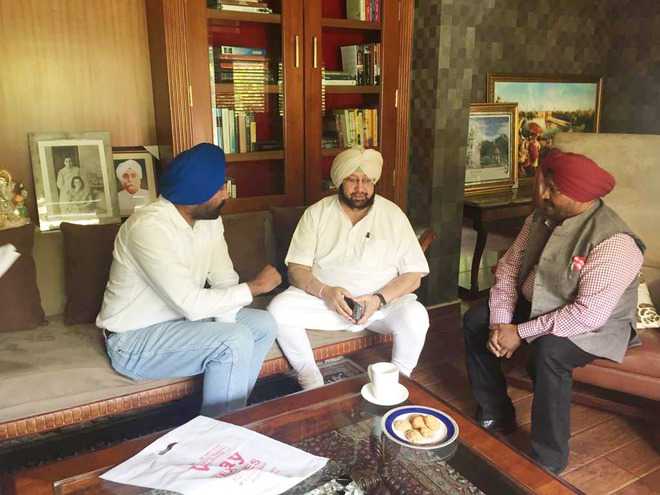 Capt Sukhjit Singh Hara (left) and Gill MLA Kuldeep Singh Vaid (right) with Chief Minister Amarinder Singh during a meeting in Chandigarh. A Tribune photo
Capt Sukhjit Singh Hara (left) and Gill MLA Kuldeep Singh Vaid (right) with Chief Minister Amarinder Singh during a meeting in Chandigarh. A Tribune photoOur Correspondent
Sahnewal, March 29
Captain Sukhjit Singh Hara, a close associate of Chief Minister Captain Amarinder Singh, along with Gill constituency MLA, Kuldeep Singh Vaid, met the Chief Minister at his Chandigarh residence recently.They apprised the Chief Minister of various problems of Gill and Sahnewal. The focus of the discussion was Sahnewal airport which has almost been abandoned due to a meager number of flights.“I shared with Captain Amarinder Singh that Ludhiana based industrialists and business tycoons were facing a lot of problems. Foreign delegates reach Delhi but avoid visiting to Ludhiana for business meetings due to no flight connectivity. To finalise deals businessmen from Ludhiana have to go to Delhi, which is a major problem,” said Sukhjit Hara.While accusing the SAD-BJP led government he said “Akali government just believed in showing off. The last government spent a huge amount of money for the aerodrome but it was all futile,” he added.Kuldeep Singh Vaid also stated problems of drugs in his constituency. He made the Chief Minister aware about the number of ‘bastis’ in his constituency where drug menace was expected to be on higher side.Vaid told that if he is given assistance by the Chief Minister as well as proper coordination was maintained with the police and public, he would be able to do solve the problem of drug addiction. Hara said that the Chief Minister assured that he would take personal interest in solving the problems.










